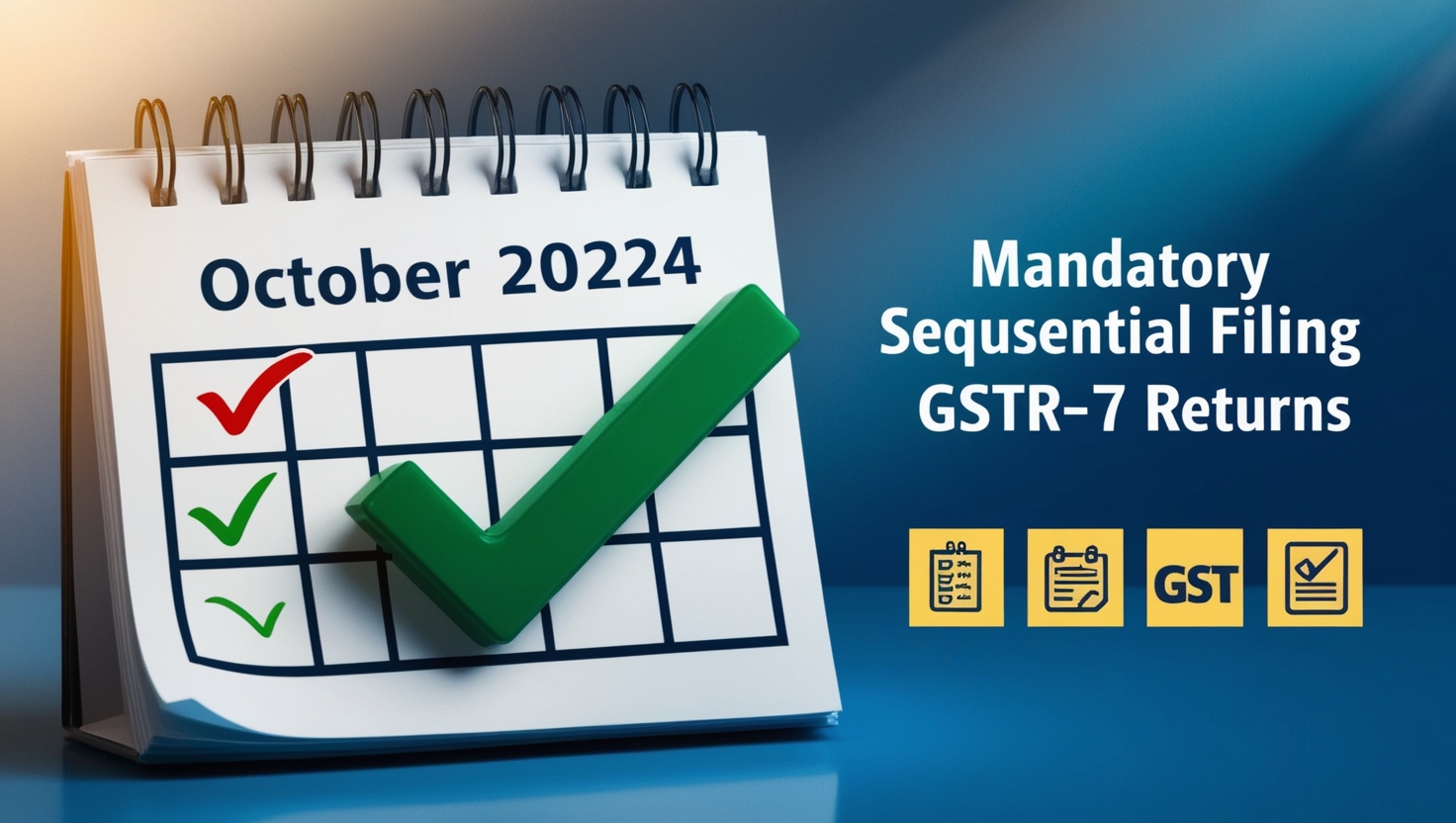Mandatory Sequential Filing of GSTR-7 Returns: Everything You Need to Know
The mandatory Sequential Filing of GSTR-7 Returns has brought a significant change in how taxpayers file their GST returns. This change, effective from November 1, 2024, has been introduced through Notification No. 17/2024-Central Tax dated September 27, 2024. The sequential filing mandate ensures that GSTR-7 returns are filed in chronological order, starting from October 2024.
In this article, we’ll delve into the details of this mandatory compliance, its implications, and the steps taxpayers need to take to adapt to this change.
What is GSTR-7?
Before understanding the sequential filing requirement, let’s revisit what GSTR-7 entails.
- GSTR-7 is a return filed by tax deductors under GST.
- It records the details of tax deducted at source (TDS) under GST provisions.
- Taxpayers must file this return by the 10th of the following month.
With the introduction of mandatory Sequential Filing of GSTR-7 Returns, the process for filing has become stricter, ensuring all returns are submitted in the correct order.

What is Mandatory Sequential Filing of GSTR-7 Returns?
The mandatory Sequential Filing of GSTR-7 Returns requires taxpayers to:
- File returns in chronological order, beginning with the October 2024 tax period.
- Complete all previous pending GSTR-7 filings before moving to subsequent periods.
For example:
- If a taxpayer has not filed the return for October 2024, they cannot file for November 2024 or any later period.
Key Features of Sequential Filing of GSTR-7
- Chronological Order Filing:
- Starting from October 2024, all GSTR-7 returns must follow a sequence.
- NIL Return Requirement:
- If no deductions have been made for a specific period, taxpayers must file a NIL return to maintain compliance with the sequential order.
- Revised FAQs:
- While earlier FAQs indicated that sequential filing was not mandatory, this advisory confirms that the mandatory Sequential Filing of GSTR-7 Returns is now in effect.
Implications of the Sequential Filing Mandate
- Compliance Challenges:
Taxpayers with pending GSTR-7 returns from earlier periods must clear them to file returns for subsequent months. - Risk of Filing Delays:
Failure to file GSTR-7 returns in sequence may result in delays, penalties, and disruption in compliance. - Administrative Adjustments:
Businesses need to update their filing processes and ensure that TDS records are complete for each tax period.

Steps to Comply with the Sequential Filing Mandate
- Review Filing History:
- Taxpayers must check their GSTR-7 filing records and clear any pending returns, particularly for periods before October 2024.
- File NIL Returns When Necessary:
- For months with no deductions, ensure a NIL GSTR-7 return is filed to maintain the sequence.
- Monitor Filing Deadlines:
- The due date for filing GSTR-7 remains the 10th of the following month, so ensure timely compliance to avoid breaking the sequence.
- Seek Assistance When Needed:
- For any technical or procedural issues, taxpayers can contact the GSTN helpdesk for support.
Why Sequential Filing is Mandatory for GSTR-7
The mandatory Sequential Filing of GSTR-7 Returns ensures better compliance and transparency in GST processes. By maintaining a chronological order of filings, the GST system can better track TDS deductions and filings, reducing errors and omissions.
Conclusion
The introduction of the mandatory Sequential Filing of GSTR-7 Returns is a critical step toward streamlining GST compliance. By requiring returns to be filed in chronological order, the system ensures accuracy and reduces discrepancies in tax deductions.
Taxpayers should review their filing history, clear pending returns, and file NIL returns when required to comply with the new rules. For any challenges, the GSTN helpdesk is available to provide support. Staying updated with GST notifications and changes is key to maintaining compliance and avoiding penalties.
Make sure your GSTR-7 returns are always in sequence to ensure smooth GST compliance!
Q1: When does the sequential filing rule come into effect?
Q2: Is it mandatory to file NIL GSTR-7 returns?
Q3: What happens if I fail to file a return in sequence?
Q4: Where can I seek help for filing issues?
Q5: What is the due date for GSTR-7 filing?
Q6: What is the difference between GSTR-7 and GSTR-3B?
GSTR-3B: A self-declared summary return filed monthly by regular taxpayers to report liabilities, claim input tax credits, and pay taxes.
Q7: What is the penalty for filing GSTR-7 late?
Q8: Can GSTR-7 be revised?
Q9: Who is exempted from TDS on GST?
Q10: Who fills GSTR-7?
Q11: What are the 3 types of GST full forms?
CGST: Central Goods and Services Tax
SGST: State Goods and Services Tax
IGST: Integrated Goods and Services Tax
Q12: How to file GSTR-7 online?
Log in to the GST portal (www.gst.gov.in).
Navigate to Returns Dashboard and select GSTR-7.
Fill in the details of TDS deducted and deposit made.
Verify using DSC or EVC, and submit the return.
For more update GST Visit here.









